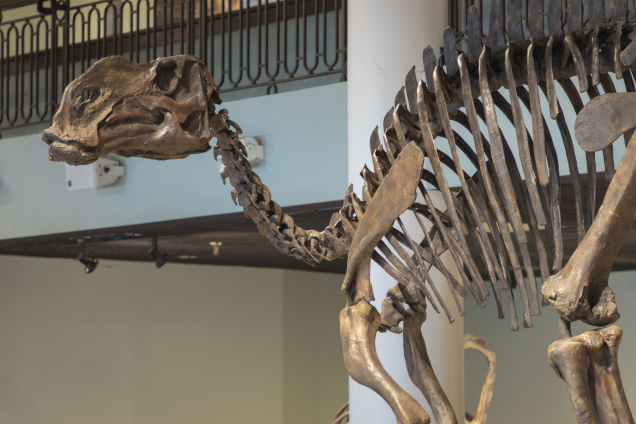Haddy Returns to Dinosaur Hall
The Academy’s Hadrosaurus foulkii skeleton was the first articulated dinosaur skeleton ever to be displayed for the public.
July 16, 2025
PHILADELPHIA, July 16, 2025 — The Academy of Natural Sciences of Drexel University (the Academy) is hailing the return of a restored mount of
Hadrosaurus foulkii to Dinosaur Hall. The return of this historic dinosaur is now on view to the public and will be celebrated Friday, July 25 as part of the Academy’s signature program Dinos After Dark.
Haddy, the 20th-century nickname for Hadrosaurus foulkii, was discovered in 1858 in Haddonfield, N.J. While only a portion of the fossilized dinosaur was found, the British artist Benjamin Waterhouse Hawkins created a full cast of the skeleton under the direction of Academy Curator Joseph Leidy, who named and first described the species in 1859. The original fossils are part of the Academy’s Vertebrate Paleontology collections.
In 1868, the Academy of Natural Sciences—at the time located at Broad and Sansom streets—became the first place in the world where the public could go to see a mounted dinosaur on display. Haddy’s original display drew such large crowds that it led to the Academy instituting a fee for admission, set at ten cents.
"Hadrosaurus foulkii, or Haddy, is a bit of a local celebrity. This dinosaur represents the Academy’s place in history and is representative of its long tradition of bringing science and natural history to the public and inspiring curiosity and awe," said Ned Gilmore, Collections Manager for Vertebrate Paleontology at the Academy.
The original mount was also present when the Academy opened its current location on the Benjamin Franklin Parkway in 1876 and remained there until the 1930s. A new mount of Hadrosaurus foulkii was created for the 2008 exhibit Hadrosaurus foulkii: The Dinosaur That Changed the World. That mount, which was updated to match contemporary thinking on the dinosaur’s anatomy, has been in storage since 2020 until it was recently restored and returned to display.
Hadrosaurus foulkii likely lived about 80 million years ago in the Campanian, Late Cretaceous Period in the forested, coastal regions of what is now New Jersey.
Hadrosaurus foulkii was excavated from Haddonfield, New Jersey in 1858 by lawyer and historian William Parker Foulke and his farmer friend, John Hopkins who lived on the land of the excavation site.
“The return of the Hadrosaurus foulkii to full display at the Academy of Natural Sciences is a proud moment for Haddonfield. This remarkable dinosaur, affectionately known as Haddy, was discovered right here in our town and played a significant role in shaping the world’s understanding of prehistoric life. Haddy isn’t just a fossil; the discovery is part of our identity and a symbol of Haddonfield’s place in history. We’re thrilled to see this important specimen restored and honored once again, and we’re grateful to the Academy for preserving such a meaningful piece of both scientific and local heritage,” said Haddonfield Mayor Dave Siedell.
While Haddy was the first of the group to be discovered, many more species of hadrosaurids are known today. They get their nickname as the “duck-billed” dinosaurs from their wide and flat snouts. The plant-eater was later declared New Jersey’s official state dinosaur and the site where it was discovered is a national historic landmark. Although hadrosaurids originated in North America, their movements across land bridges resulted in their eventual presence on all seven continents.
The return of Haddy to Dinosaur Hall will be celebrated Friday, July 25 at the Academy’s Dinos After Dark program from 5 – 8 p.m., where staff will be joined by representatives from the Historical Society of Haddonfield. Dinos After Dark is the Academy’s popular
pay-what-you-wish evening with extanded hours, food and drink options and exciting programs for all ages. Dinos After Dark will be followed by the Mid-Summer Dino Ball, with a beer garden, food trucks and dance party. Tickets for the Dino Ball are $20 ($15 for members). For more information visit ansp.org/programs-and-events/festivals/dinos-after-dark.

Hadrosaurus foulkii, or "Haddy", is on view now in Dinosaur Hall at the Academy of Natural Sciences of Drexel University. Photo by John Hutelmyer/ANS.
Contact
Kaitlyn Foti Kalosy
kfk38@drexel.edu
215-299-1777
About the Academy of Natural Sciences of Drexel University
Founded in 1812, the Academy of Natural Sciences of Drexel University is a leading natural history museum and scientific research organization dedicated to understanding the natural world and inspiring everyone to care for it. The Academy is a constant source of innovation, education and engagement with environmental justice. It is home to more than 19 million scientific specimens in its world-class collections. Learn more at ansp.org and follow the Academy on Facebook, Instagram, TikTok and LinkedIn.